Programmer(s) Hiroshi Momota | Director(s) Noriyoshi Ohba Initial release date 2 August 1991 Genre Beat 'em up | |
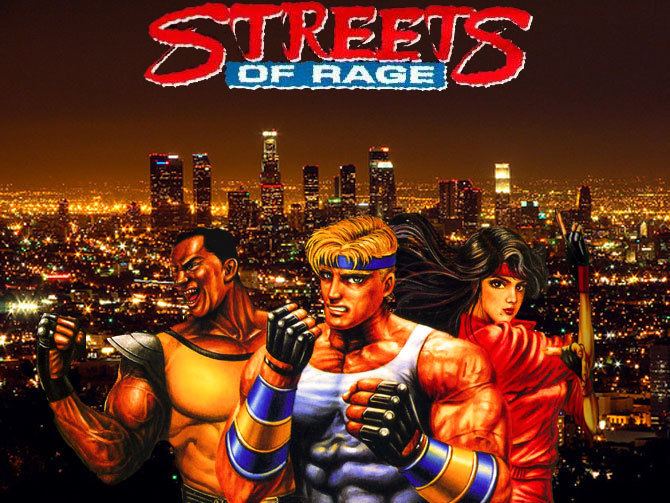 | ||
Designer(s) Noriyoshi OhbaHiroaki Chino Developers Sega, Overworks, Sega Wow, Magical Similar Overworks games, Beat 'em up games | ||
Streets of Rage (ベアナックル 怒りの鉄拳, Bea Nakkuru: Ikari no Tekken, "Bare Knuckle: Furious Iron Fist") is a side-scrolling beat 'em up video game developed and published by Sega in 1991 for Mega Drive/Genesis. It is the first installment of the Bare Knuckle/Streets of Rage series which was followed by Streets of Rage 2 and Streets of Rage 3. The game was converted to Game Gear, Sega CD and Master System. In 2007, the game was released for the Wii's Virtual Console in North America and Europe, and in 2009 it was released for the iOS via the App Store. It was again made available as part of Sonic's Ultimate Genesis Collection in 2009 on both the PlayStation 3 and Xbox 360 consoles.
Contents
Gameplay

Like in the game Golden Axe which was released two years prior by Sega, enemies walk onto the screen from both sides as well as occasionally appearing from other locations. The player must defeat each opponent to progress through eight locations, known as rounds. With the exception of round 7, there is a boss battle at the end of every round with a disproportionately large enemy. Unlike its sequels, none of the enemies are named within the game (they are named only in the Japanese version's manual) and only the bosses have life gauges. As in contemporary games Double Dragon and Final Fight, the player can pick up weapons, which include knives, bottles, and drainpipes. In Streets of Rage, the special attack has assistance from a police car, which enters the screen from the left and fires explosives, taking health from all enemies. The player is given one special attack per life or per level and power-ups shaped like police cars supply another. In round 8, the special attack can't be used.
There are three playable characters in the game:
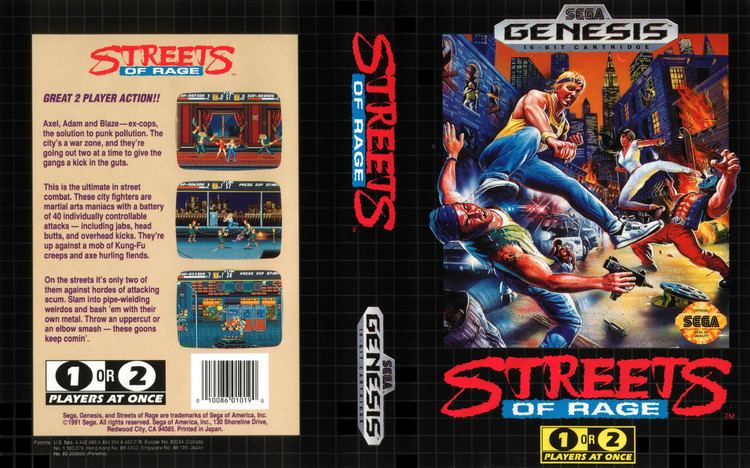
- Adam Hunter possesses high power and jump ability, but slow movement.
- Axel Stone is high-powered and moves quickly, but has poor jump ability.
- Blaze Fielding moves faster than the others and has good jump ability, but is the weakest character.
Plot
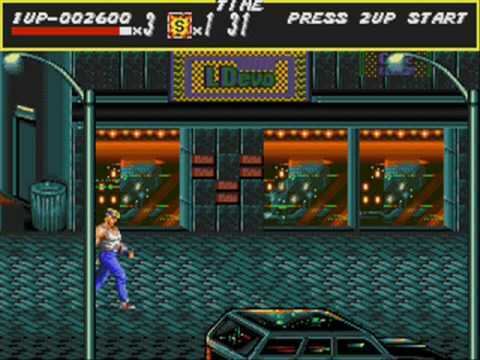
The once peaceful city has been taken over by a criminal syndicate, including factions of the police. Mass violence is now common and no one is safe. Adam Hunter (an accomplished boxer), Axel Stone (skilled martial artist) and Blaze Fielding (judo expert) are young ex-police officers who have quit the force to fight back against the syndicate.
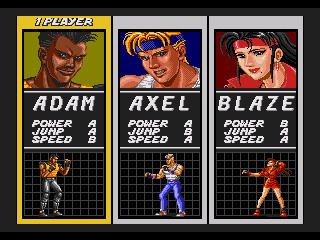
Depending on whether the game is played as one-player or a two-player co-op, and whether the player accepts or rejects Mr. X's offer to join his henchmen, there is a possibility for an alternate ending where the player becomes the new head of the crime syndicate.
Collections
A signature title and franchise for Sega during the Mega Drive era, the title was collected often.
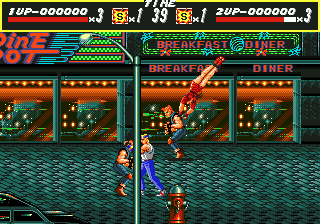
Reception
MegaTech magazine said it had "excellent sprites, backdrops and brilliant music. Add in great gameplay and simultaneous two-player action and you've got an essential buy." Mega placed the game at Number 6 in its Top Mega Drive Games of All Time.
Reviewing the game's appearance in Sega Arcade Classics for the Sega CD, Glenn Rubenstein said it "still holds up well."
Legacy
Streets of Rage was followed by two sequels, Streets of Rage 2 and Streets of Rage 3. There were plans for two further sequels, one of which was developed by Core Design for the Sega Saturn, but Sega pulled the Streets of Rage name during development after a disagreement with Core about porting it to rival formats; the game was eventually released as Fighting Force.
Comics
Three six-part comic strip series based upon the games appeared in Sonic the Comic in the early 1990s (along with several other adaptations of popular Sega franchises). The first two of these was written by Mark Millar, who has since become popular writing The Authority for Wildstorm and Ultimate X-Men and The Ultimates for Marvel, while the third (along with a Poster Mag story) was written by Nigel Kitching. Peter Richardson produced the artwork for all nineteen episodes. These three stories are based on Streets of Rage 2 and do not feature Adam. A graphic novel compilation of the original 5-part "Streets of Rage" strip was released as a book called "Streets of Rage: Bad City Fighters" in the UK in 1994.
The first story, entitled simply Streets of Rage, appeared in STC #7–12 and involved Axel, Blaze, and Max quitting the highly corrupt police force to do more good as vigilantes, taking down Max's ex-partner, the crime lord and martial artist Hawk.
The next serial, Skates' Story, appeared in STC #25–30 and introduced Skates, delinquent stepson of Murphy, a friend of Axel and his team and one of the few honest cops left on the force, who was unwillingly drawn into joining Axel's group after his parents were killed by Mr X.
A special one-off story, called The Facts of Life, appeared in "Sonic the Poster Mag" #7 and involved the heroes causing a racket by fighting one of the many street gangs in a sleeping neighborhood. The police arrive and arrest the thugs, as well as take the heroes to a junkyard for execution. Along the way, Axel explains why he, Blaze, and Max quit the force to a young rookie officer. At the junkyard, just as the officers are about to shoot Max, the rookie officer unlocks Blaze's handcuffs, who proceeds to beat the stuffing out of the cops, with Axel, Skates, and Max following shortly. After the dust clears, the rookie officer says that he's seen the true colors of the police force and requests that Axel hit him. Axel does so until Blaze tells him to stop, and they and Max and Skates leave as dawn breaks.
The third and final serial, called The Only Game In Town, appeared in STC #41–46 and involved the Syndicate unleashing an army of street gangs on our heroes, with the event turned into a gambling event as Mr. X opened a book based on whether or not the heroes would reach the river without being killed first. This ploy was played against the villain when Blaze bet $20,000 on her team's survival at odds of a thousand to one. This third story was notable for revealing that, for his failure, the old Mr. X had been the victim of a "swimming accident" and had been replaced with a new one by the Syndicate at story's end. Like many non-Sonic stories in this magazine, the story had a cliff-hanger ending, with the new Mr. X promising that he would "recoup his losses" and kill the heroes.
Soundtrack
The game's soundtrack was acclaimed, with several soundtrack albums being released. The soundtracks were composed by Yuzo Koshiro. Another musician, Motohiro Kawashima, helped on the second, providing a few tracks, and making even more for the third. Three soundtrack CDs were released in all, each of which now sell for high prices at auction and in Japanese markets.
When the first game's development began in 1990, Koshiro was influenced by electronic dance music, specifically house, techno, and rave, and wanted to be the among the first to introduce those sounds in video games. The soundtrack shows the influence of contemporary R&B and hip hop music. Koshiro said "the most important element in recreating club music sounds for the games was to emulate the timbre and percussion sounds of Roland's rhythm machines" (the most famous models being the TR-606, TR-707, TR-808, and TR-909), stating that "it wouldn't be an exaggeration to say that that sound defined the genre."
Animated
Sega has formed the production company Stories International and teamed up with Evan Cholfin for film and TV projects based on its games, with Streets of Rage as an animated project.
